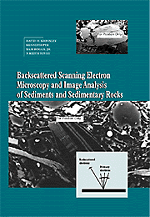Preface
Published online by Cambridge University Press: 21 January 2010
Summary
This book focuses on the study of sedimentary rock thin sections using images obtained from the scanning electron microscope (SEM) in the backscattered electron mode (BSE). About half the text consists of description and analysis, and the rest SEM micrographs. Until now, there has not been a book available that provides BSE information on the various sediments and sedimentary rock types. We hope the book will provide an analytical tool for sedimentologists and others who may profit from a reference volume for use in their studies.
The earliest known work concerning the construction of an SEM was published in 1938. Much of the subsequent development was done in the engineering department of the University of Cambridge between 1948 and 1965. The first BSE pictures with good resolution were produced in the 1970s. Today, BSE photographs of sediments and sedimentary rocks appear regularly in the major sedimentological journals.
The basic components of an SEM are the lens system, electron gun, electron collector, visual and recording cathode ray tubes (CRTs), and the electronics associated with them. BSE is simply one of the operational modes. Electrons from the primary beam of an SEM strike the atoms of a sample and are reflected or scattered (backscattered) out of the material at high angles. These electrons are collected and used to produce a gray-level photograph that contains both compositional (atomic number) and topographic information.
Information
- Type
- Chapter
- Information
- Backscattered Scanning Electron Microscopy and Image Analysis of Sediments and Sedimentary Rocks , pp. vii - viiiPublisher: Cambridge University PressPrint publication year: 1998
